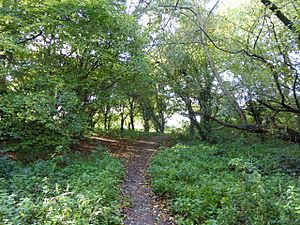Cocksherd Wood facts for kids
Quick facts for kids Cocksherd Wood |
|
|---|---|
 |
|
| Type | Local Nature Reserve |
| Location | Slough, Berkshire |
| OS grid | SU 945 828 |
| Area | 4.8 hectares (12 acres) |
| Managed by | Evergreen 2000 |
Cocksherd Wood is a special natural area, about the size of 7 football fields (4.8 hectares). It's a Local Nature Reserve in Slough, Berkshire. The local council, Slough Borough Council, owns it, and a group called Evergreen 2000 helps take care of it. Many people know it as Bluebell Wood because of the beautiful bluebells that grow there.
Contents
What is Cocksherd Wood Like?
This natural reserve is a mix of old woodland and open grassy areas. Some parts of the woods have been "coppiced." This means trees were cut down to ground level, allowing new shoots to grow. This method helps keep the forest healthy and provides wood.
The wood sits at the end of a "dry valley." This is a valley that was once carved by water but is now usually dry. In 1979, the woods became property of the Slough Borough Council.
History of Cocksherd Wood
Cocksherd Wood has been around for a very long time. It was even shown on an old map of Buckinghamshire made between 1766 and 1768 by Thomas Jefferys. This means the woods are at least 250 years old!
In the 1950s, the London County Council bought the woodland. This was part of a bigger plan to develop the Britwell area. Later, in 1996, the Slough Borough Council officially made Cocksherd Wood a Local Nature Reserve. This helps protect the area and its wildlife. Since 2001, a group called Evergreen 2000 has been managing the reserve. They work to keep it a great place for nature.
Animals You Might See
Cocksherd Wood is home to many different animals, especially insects and birds.
Insects and Bugs
Look out for these interesting insects flying or crawling around:
- Small skipper (a type of butterfly)
- Small tortoiseshell (another colorful butterfly)
- Meadow brown (a common brown butterfly)
- Stag beetle (a large, impressive beetle)
- Pieris brassicae (also known as the Large White butterfly)
- Ringlet (a dark butterfly with small eye-spots)
Birds in the Wood
You might hear or spot these birds in the trees and skies:
- European green woodpecker (known for its loud "yaffle" call)
- Eurasian bullfinch (a small bird with a bright pink chest)
- Red kite (a large bird of prey with a forked tail)
Plants and Trees You Can Find
The wood is full of different types of plants and trees, making it a rich habitat.
Trees in the Forest
Here are some of the trees that grow in Cocksherd Wood:
- Acer campestre (Field Maple)
- Betula pendula (Silver Birch)
- Corylus avellana (Common Hazel)
- Crataegus monogyna (Hawthorn)
- Quercus robur (English Oak)
- Fagus sylvatica (European Beech)
- Fraxinus excelsior (European Ash)
- Ilex aquifolium (Holly)
- Prunus avium (Wild Cherry)
- Prunus spinosa (Blackthorn)
- Rhododendron ponticum (Rhododendron)
- Salix caprea (Goat Willow)
- Sambucus nigra (Elder)
- Sorbus aucuparia (Rowan or Mountain Ash)
- Ulmus procera (English Elm)
Other Plants
Besides the trees, these plants also grow here:
- Lonicera periclymenum (Honeysuckle)
- Anemone nemorosa (Wood Anemone)
- Carex sylvatica (Wood Sedge)
- Hyacinthoides non-scripta (Common Bluebell) - these are the famous bluebells that give the wood its local name!
- Poa nemoralis (Wood Bluegrass)
- Vicia sepium (Bush Vetch)

